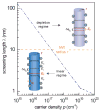Subthreshold regime has the optimal sensitivity for nanowire FET biosensors
- PMID: 19908823
- PMCID: PMC2820132
- DOI: 10.1021/nl9034219
Subthreshold regime has the optimal sensitivity for nanowire FET biosensors
Abstract
Nanowire field-effect transistors (NW-FETs) are emerging as powerful sensors for detection of chemical/biological species with various attractive features including high sensitivity and direct electrical readout. Yet to date there have been limited systematic studies addressing how the fundamental factors of devices affect their sensitivity. Here we demonstrate that the sensitivity of NW-FET sensors can be exponentially enhanced in the subthreshold regime where the gating effect of molecules bound on a surface is the most effective due to the reduced screening of carriers in NWs. This principle is exemplified in both pH and protein sensing experiments where the operational mode of NW-FET biosensors was tuned by electrolyte gating. The lowest charge detectable by NW-FET sensors working under different operational modes is also estimated. Our work shows that optimization of NW-FET structure and operating conditions can provide significant enhancement and fundamental understanding for the sensitivity limits of NW-FET sensors.
Figures




Similar articles
-
Enhanced sensing of nucleic acids with silicon nanowire field effect transistor biosensors.Nano Lett. 2012 Oct 10;12(10):5262-8. doi: 10.1021/nl302476h. Epub 2012 Sep 20. Nano Lett. 2012. PMID: 22985088
-
Silicon Nanowire Field Effect Transistor Sensors with Minimal Sensor-to-Sensor Variations and Enhanced Sensing Characteristics.ACS Nano. 2018 Jul 24;12(7):6577-6587. doi: 10.1021/acsnano.8b01339. Epub 2018 Jul 5. ACS Nano. 2018. PMID: 29932634
-
Enhanced sensing of nonpolar volatile organic compounds by silicon nanowire field effect transistors.ACS Nano. 2011 Jul 26;5(7):5620-6. doi: 10.1021/nn201184c. Epub 2011 Jun 7. ACS Nano. 2011. PMID: 21648442
-
Recent advances in nanowires-based field-effect transistors for biological sensor applications.Biosens Bioelectron. 2018 Feb 15;100:312-325. doi: 10.1016/j.bios.2017.09.024. Epub 2017 Sep 18. Biosens Bioelectron. 2018. PMID: 28942344 Free PMC article. Review.
-
Silicon nanowires as field-effect transducers for biosensor development: a review.Anal Chim Acta. 2014 May 12;825:1-25. doi: 10.1016/j.aca.2014.03.016. Epub 2014 Mar 15. Anal Chim Acta. 2014. PMID: 24767146 Review.
Cited by
-
Metal-Oxide FET Biosensor for Point-of-Care Testing: Overview and Perspective.Molecules. 2022 Nov 17;27(22):7952. doi: 10.3390/molecules27227952. Molecules. 2022. PMID: 36432052 Free PMC article. Review.
-
Micro-Raman Spectroscopy for Monitoring of Deposition Quality of High-k Stack Protective Layer onto Nanowire FET Chips for Highly Sensitive miRNA Detection.Biosensors (Basel). 2018 Jul 27;8(3):72. doi: 10.3390/bios8030072. Biosensors (Basel). 2018. PMID: 30060476 Free PMC article.
-
Understanding and Mapping Sensitivity in MoS2 Field-Effect-Transistor-Based Sensors.ACS Nano. 2020 Sep 22;14(9):11637-11647. doi: 10.1021/acsnano.0c04192. Epub 2020 Aug 18. ACS Nano. 2020. PMID: 32790325 Free PMC article.
-
Fringe-fields-modulated double-gate tunnel-FET biosensor.Sci Rep. 2024 Jan 2;14(1):168. doi: 10.1038/s41598-023-50723-y. Sci Rep. 2024. PMID: 38167467 Free PMC article.
-
BioFET-SIM web interface: implementation and two applications.PLoS One. 2012;7(10):e45379. doi: 10.1371/journal.pone.0045379. Epub 2012 Oct 8. PLoS One. 2012. PMID: 23056201 Free PMC article.
References
-
- Patolsky F, Zheng G, Lieber CM. Anal Chem. 2006;78:4260. - PubMed
-
- Cui Y, Wei Q, Park H, Lieber CM. Science. 2001;293:1289. - PubMed
-
- Zheng G, Patolsky F, Cui Y, Wang WU, Lieber CM. Nat Biotechnol. 2005;23:1294. - PubMed
-
- Li C, Curreli M, Lin H, Lei B, Ishikawa FN, Datar R, Cote RJ, Thompson ME, Zhou C. J Am Chem Soc. 2005;127:12484. - PubMed
-
- Stern E, Klemic JF, Routenberg DA, Wyrembak PN, Turner-Evans DB, Hamilton AD, LaVan DA, Fahmy TM, Reed MA. Nature. 2007;445:519. - PubMed
Publication types
MeSH terms
Substances
Grants and funding
LinkOut - more resources
Full Text Sources
Other Literature Sources

